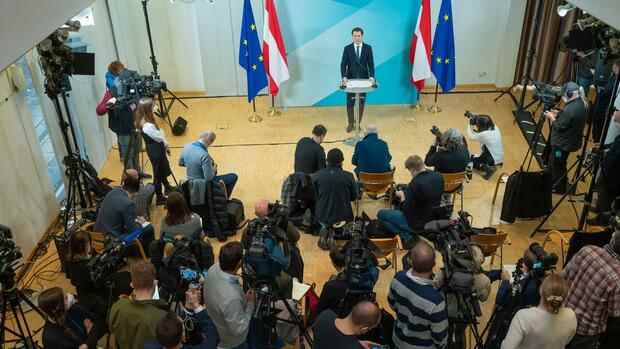Vienna You are “on thin ice”, said the then Chancellor Alexander Schallenberg in mid-October after he was determined to be Sebastian Kurz’s successor in a push-button action. In view of the dramatic events of the past 24 hours, one has to state that it has broken in crucial places, and nobody knows whether the rest of the hard surface is strong enough to carry Austria’s government forward.
It is all the more hectic that it is demonstrating its ability to act: On the defensive, because of the errors in corona management, charges against its top staff and collapsing survey figures, the party, which has been co-ruling almost continuously for 35 years, lets Kurz and his confidants fall in panic in the midst of the fourth lockdown.
Top jobs of the day
Find the best jobs now and
be notified by email.
In 2017, they took over the then stumbling People’s Party – with the promise of modernization. A new, “turquoise” power structure was grafted onto the old “black” leadership.
Kurz-Abgang causes a power shift in the ÖVP
The new color disappeared with the political star, and the old structures emerge underneath. The powerful governors are again setting the tone. You are already thinking out loud about reversing the extensive control rights that Kurz has stipulated as party leader.
The breathtaking pace of this power shift is a backlash against the disruptive political style that Kurz had shaped. His decision to break up the traditional grand coalition with the Social Democrats was just as understandable as it was inconsiderate.
It polarized and destabilized politics: Kurz became chancellor twice, first for 17 months, then for 21. The ÖVP minority government only lasted a few days in 2019, the cabinet of experts under Brigitte Bierlein was in office for seven months, and Schallenberg is now expected to be less than two. This will take over the function of the foreign minister again.
Probably the most important “player” is the Governor of Lower Austria, Johanna Mikl-Leitner, who heads the most powerful formation in the People’s Party. Not only Nehammer and the new interior minister come from this, but also the new-old ÖVP parliamentary group leader August Wöginger.
As the governor of Lower Austria, Mikl-Leitner is one of the most powerful ÖVP politicians.
(Photo: dpa)
Mikl-Leitner and her predecessor pioneered Sebastian Kurz’s career. He and his confidants had their base in Lower Austria, in Vienna and in the youth organization. The relationship with other regional princes, in Tyrol, Upper Austria and Salzburg, was more distant – that with Styria recently tense. Everyone supported Kurz as long as he seemed to have no alternative as a guarantee of success. When it became the mortgage, they dropped it.
It is no secret that the new-old ÖVP leadership regards the government alliance as a marriage of convenience even more than Kurz did. He accepted it because he lacked the alternatives; the Social Democrats and the right-wing populist FPÖ were passionately disliked in view of the burdened common history. The “black” ÖVP would be much less averse to a resurgence of the grand coalition.
This is all the more the case as many conservatives see the Greens’ withdrawal of support for Kurz in October as treason. In return, the eco party is courteous in the current government reshuffle and is scattering Nehammer roses. It seems like a prisoner of the current predicament: If the government falls, prestige projects by the Greens, such as the eco-social tax reform and the introduction of a general season ticket, are also acutely at risk.
Parties fear new elections
On the grounds that political stability requires quick solutions, the actors repeatedly broke new ground in the changes and strained the constitution without breaking it. Federal President Alexander Van der Bellen played the role of willing partner as well as the guarantor of compliance with the basic rules.
And yet the castling since Kurz’s resignation in October gives the impression that the ÖVP is using its politicians like pawns – although today it is much less clear who moves it.
Neither party is really interested in early elections: the political actors are all short of funds, and the ÖVP is threatened with a slump. Social democrats and the FPÖ could expect gains, but they are fighting internal conflicts and would hardly distance the conservatives decisively.
In addition, there is the fear of all established parties except for the coronaskeptic Freedom Party of an election campaign that would foreseeably revolve around errors in pandemic management and the planned mandatory vaccination. Nevertheless, the turbulence and loss of control of the past few months have made it much more likely that the polls will be brought forward.
Nehammer is confronted with a mammoth task: He has to cope with the pandemic, settle the conflicts in the government and mediate between the inner-party desires, which are likely to become more contradictory in view of the resurgence of the traditional centers of power.
Kurz had kept the latter under control – through his personal charisma, through the promotion of loyalists, but also through an extremely flexible political course, with the exception of migration and tax policy. He changed the party, a simple return to the past is not possible for the ÖVP. Rather, the search for a new equilibrium begins – both within the party and in government. Walking on thin ice remains dangerous.
More: Hesitant, aimless, quarreling – How Austria’s government broke the country’s fourth lockdown
